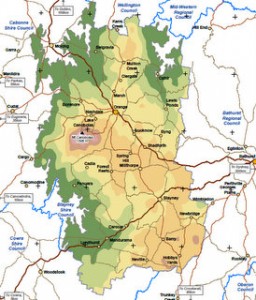Orange Terroirists
In October 2010, the Orange Region Vignerons’ Association published a booklet on the terroir of their region – ‘Orange Region Terroir’ – marking a line in the sand (basalt?) that states the intention of the region to produce wines of place, and that place is Orange.

Orange altitudes
The booklet is crammed with all the useful information and data to make a serious wine student’s eyes water with expectation: topography, geology, climate, weather, soils, and the effects of altitude (within Orange) on the flavour profile of the main grape varieties grown in the region. Viticultural consultant, proprietor of Hedberg Hill, and Charles Sturt University lecturer, Peter Hedberg contributed to the booklet.
He explained “There is a young – 12 million years old – cap of basalt, which overlays 400 million year old soils of gravels, shales, limestones etc. On top of it all is a deep, red friable soil.” He said the area used to be 5,000m high “but erosion has exposed granite batholites”, adding “limestone breaks out to the surface at elevations of 600 to 700m.”
Effectively there are different geologies approximately according to altitude. Above 800m are the young volcanic basalts under deep, loamy soils. Up to 800m are older volcanics covered by lighter loamy soils. And around 600m are ancient soils derived from those limestones, shales, greywacke etc.
Phil Kerney, winemaker at Ross Hill wines, and Orange-based contract winemaker for others, said that at the 1,000m Ross Hill site “we’re basalt-derived soils. But at the Ross Hill original block near Bloodwood, at about 780m, the soils are ancient, weathered granites.”
As part of the traditional model of terroir, it is the land, rather than the winemaker, that should speak. Mayfield Vineyard’s owner Richard Thomas said “we don’t want the winemakers’ fingerprints on the wines. We very much want an expression of the vineyards, a certain place, a certain time.”
However many, Mayfield included, send their fruit out of the region to be made under contract elsewhere. Small scale has been cited as a deterrent to setting up a winery and making one’s own wine. But the terroir model comes from Europe, where there are enough producers growing and making their own wines from just a few hectares of intimately-known vineyards, that this alone ought to inspire Orange folk to turn to on-site winemaking to gain close control of the product that bears their names.
It’s not to say that good wines aren’t already being made, just that they might be better by keeping tighter control of the whole process from vineyard to bottle. Indeed Mayfield were in my favourite wine selection from Orange.
Kerney said “I’ve worked all over the country and in Europe. My style is traditional winemaking with modern materials.” And in two short years, he’s beginning to overcome this resistance to a more vineyard-based winemaking for his contract clients, saying “we make wines to express the terroir of their vineyards. They pick when I advise. And they come out with a unique wine, but people still shy away from this, saying it’s too complicated.” It might be a bit complicated – in those two years, Kerney has made more than a hundred batches of wine, not necessarily large quantities, but winemaking on site is the only realistic option to be able to fully express vineyard site.
It jars somewhat that so many growers send off their fruit to contract winemakers, usually outside the region. To a European this is the antithesis of terroir. A primary tenet of the European model of terroir is the intimate husbandry of the land and of winemaking by one and same team, in order to coax the best expression of terroir from the fruit during winemaking.
Orange is inordinately young. As producers get to grips with the evident potential of their region, investment in own-winemaking facilities is bound to follow, possibly once the world begins to emerge from the global financial crisis, and capital investment no longer looks quite so risky.
My research visit to Australia in October 2010 was sponsored by Wine Australia.



